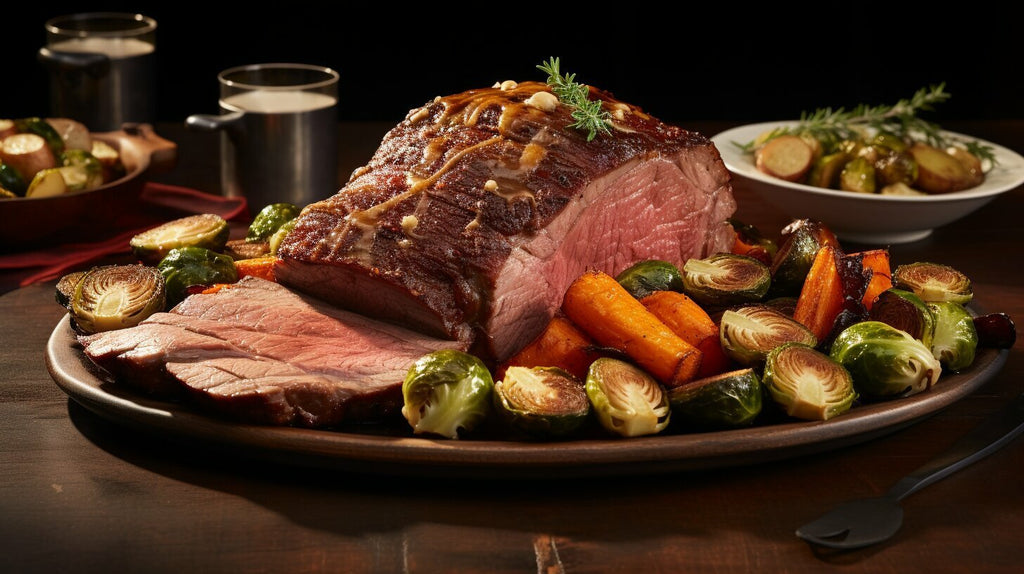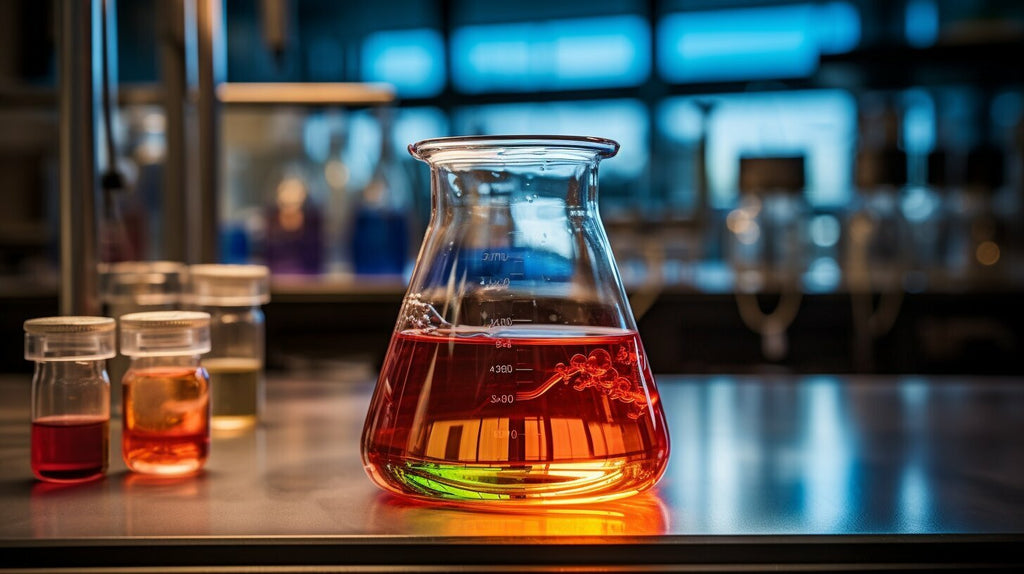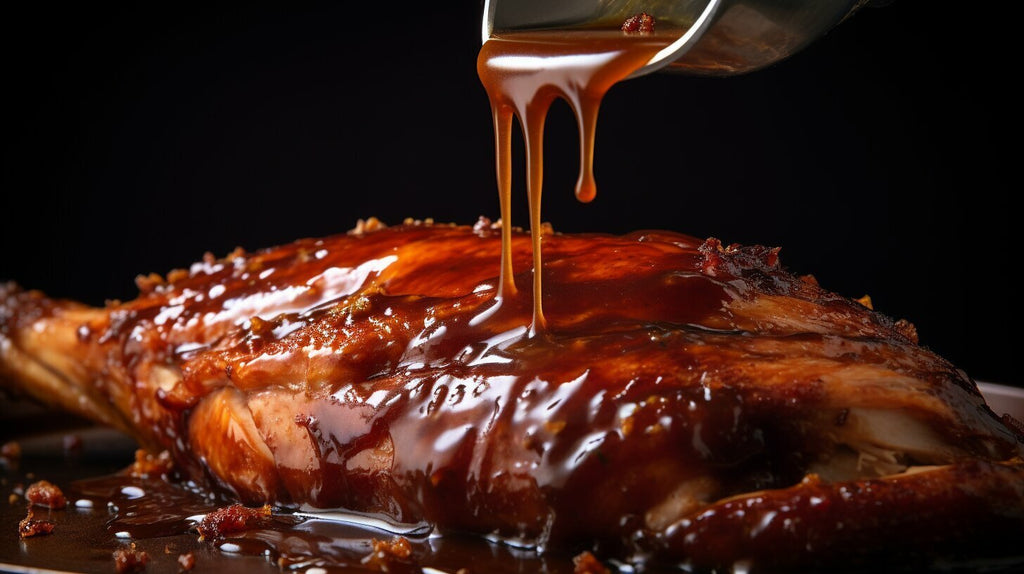
The Secret to Silky Gravies: Hydrocolloids in Classic Thanksgiving Roasts
SUBSCRIBE TO OUR BLOG
Promotions, new products, and recipes.
Greetings fellow food enthusiasts! With Thanksgiving just around the corner, I'm excited to share with you an ingredient that will take your classic Thanksgiving roasts to the next level. Have you ever wondered how to achieve that silky smooth gravy that perfectly complements your turkey and mashed potatoes? Look no further than hydrocolloids.
Hydrocolloids may sound like a mouthful, but trust me, they are the secret to creating the perfect gravy texture. In this article, I will introduce you to hydrocolloids and their role in creating silky gravies for your Thanksgiving feast. Get ready to elevate your gravy game!

Key Takeaways:
- Hydrocolloids can transform the texture and flavor of gravy in classic Thanksgiving roasts.
- Hydrocolloids are substances that can form gels or thicken liquids and are often used as stabilizers, emulsifiers, and thickeners in food preparation.
- Hydrocolloids help stabilize emulsions and prevent separation, giving your gravy a long-lasting, silky finish.
- Some common types of hydrocolloids used in food preparation include agar agar, carrageenan, xanthan gum, and guar gum.
- When using hydrocolloids in gravies, it's important to follow some basic tips for optimal results and experiment with different dishes for a culinary adventure.
What are Hydrocolloids?
As a copywriting journalist, I'm always on the lookout for the latest culinary innovations that can enhance our dining experience. One such innovation that has caught my attention is hydrocolloids. Hydrocolloids are substances that have the ability to form gels or thicken liquids, and they are often used as stabilizers, emulsifiers, and thickeners in food preparation.
Hydrocolloids can come in various forms such as gels, gums, or powders, and are derived from natural sources like plants or seaweed. They have truly revolutionized the food industry, allowing chefs to create unique textures, flavor combinations, and presentations.
When it comes to hydrocolloids, there are several common types used in food preparation:
| Hydrocolloid | Type | Function |
|---|---|---|
| Agar | Gel | Forms strong gels at room temperature, derived from seaweed |
| Carrageenan | Gum | Often used as a thickener, derived from seaweed |
| Xanthan gum | Gum | Polysaccharide used as a stabilizer and thickener |
| Guar gum | Gum | Polysaccharide used as a stabilizer and thickener |
As you can see, hydrocolloids offer a plethora of possibilities in food preparation. From gels to gums, these magical ingredients can take your culinary creations to new heights of deliciousness.

How Hydrocolloids Enhance Gravies
Hydrocolloids are the secret to silky gravies that elevate your Thanksgiving roast to the next level. These magical ingredients improve the texture and mouthfeel of your gravy, creating a smooth and velvety consistency that makes it more luxurious and enjoyable. Hydrocolloids also help stabilize emulsions and prevent separation, giving your gravy a long-lasting, silky finish.
The use of hydrocolloids in gravies enhances their thickness and allows them to hold onto the meat's juices, adding to the flavor and overall appeal of your dish. They can also minimize lumps and separation, resulting in a rich, silky, and homogeneous texture throughout your gravy.
Hydrocolloids, such as xanthan gum and carrageenan, work as thickening agents that improve the viscosity and structure of your gravy, creating a dense, smooth consistency that pairs well with the tender meat. The addition of these substances also enhances the moisture content of your gravy, preventing it from being dry or tasteless.

In summary, hydrocolloids are the key to creating the ultimate silky gravies. They improve the texture, emulsification, and consistency of your gravy, making it a delicious addition to any Thanksgiving feast.
Common Types of Hydrocolloids
Hydrocolloids are a diverse group of substances that can be classified into different categories based on their properties. Some hydrocolloids form gels, while others thicken liquids or stabilize emulsions. Here are some of the most common hydrocolloids used in food preparation:
| Hydrocolloid | Type | Function |
|---|---|---|
| Agar | Gel | Forms strong gels at room temperature, derived from seaweed |
| Carrageenan | Gum | Often used as a thickener, derived from seaweed |
| Xanthan gum | Gum | Polysaccharide used as a stabilizer and thickener |
| Guar gum | Gum | Polysaccharide used as a stabilizer and thickener |
Agar and carrageenan are both derived from seaweed and are commonly used in the food industry due to their ability to form strong gels and stabilize emulsions. Xanthan gum and guar gum are both polysaccharides and are frequently used as stabilizers and thickeners in various food products. Whatever hydrocolloid you choose, it is essential to use it in the right proportions to achieve the desired texture and consistency.

Hydrocolloids in Gravy-Making Techniques
Hydrocolloids can enhance the texture of gravies, creating a silky smooth consistency that elevates the dining experience. There are several ways to incorporate hydrocolloids into gravy-making techniques, such as adding them directly to the gravy mixture during cooking or pre-hydrating them in a liquid before incorporating them. The choice of hydrocolloid and its concentration will depend on the desired texture and consistency of the gravy.

For example, xanthan gum is a popular choice for gravy-making due to its superior thickening and stabilizing properties. It only requires a small amount to achieve the desired texture and can be added directly to the gravy mixture during cooking. On the other hand, agar and carrageenan require pre-hydration in a liquid before use and are better suited for creating thicker gravies or sauces.
When using hydrocolloids in gravy-making, it's important to mix them in thoroughly to ensure even dispersion and prevent clumping. It's also recommended to start with small amounts and adjust accordingly, as hydrocolloids can be quite potent and a little goes a long way. With the right technique and choice of hydrocolloid, you can create silky gravies that will have your guests coming back for seconds.
Tips for Using Hydrocolloids in Gravies
As a professional copywriting journalist, I have discovered some tips and tricks for incorporating hydrocolloids in gravies. These tips will help you achieve the perfect silky texture and mouthfeel for your Thanksgiving gravy.
- Choose the right hydrocolloid: Different hydrocolloids have varying properties that affect the texture of your gravy. Choose the one that suits your desired outcome. For example, xanthan gum produces a thicker and more elastic texture, while guar gum has a creamier and smoother texture.
- Use small amounts: Hydrocolloids are potent ingredients, so only a small amount is needed to achieve the desired texture. Using too much can result in a slimy or gummy texture.
- Mix thoroughly: Hydrocolloids should be thoroughly mixed into the gravy to ensure even dispersion and prevent clumping. Use a whisk or blender to mix the hydrocolloid into the gravy.
By following these tips, you can make the most out of hydrocolloids and create the perfect silky gravy for your Thanksgiving feast.

Hydrocolloids Beyond Gravies
Hydrocolloids are not just limited to creating silky gravies for your Thanksgiving feast. The versatility of these magical ingredients extends to a wide range of culinary applications.
For example, hydrocolloids can be used to thicken and stabilize soups and sauces, giving them a richer texture and flavor. They can also enhance the creaminess of desserts, such as custards and ice creams, making them more indulgent and satisfying.
But the use of hydrocolloids doesn't stop there. They can also be added to beverages, such as smoothies and juices, to improve their mouthfeel and texture.
With the endless possibilities that hydrocolloids offer, it's no wonder that chefs and food scientists are constantly experimenting with these ingredients to create innovative dishes and presentations.
So, don't be afraid to think outside the box and explore the versatility of hydrocolloids in your cooking. Who knows? You might just discover a new favorite dish or flavor combination.

Other Benefits of Hydrocolloids
If you thought silky gravies were the only benefit hydrocolloids offer, think again! These ingredients can provide a range of benefits that can elevate your culinary creations to new heights.
One major advantage of hydrocolloids is their ability to improve the shelf life of food products. By stabilizing emulsions and preventing separation, they can help keep food fresh for a longer period of time. This makes them a popular choice for packaged foods and baked goods.
Hydrocolloids can also improve freeze-thaw stability, making them ideal for frozen products like ice cream or frozen meals. They can help prevent the formation of ice crystals and maintain a smooth, consistent texture throughout the freezing and thawing process.
Aside from these technical benefits, some hydrocolloids are also sources of dietary fiber, which can contribute to digestive health. For example, carrageenan, a type of seaweed-derived hydrocolloid, has been shown to have prebiotic properties and may improve gut health.
So, whether you're looking to enhance shelf life, improve texture, or boost nutritional value, hydrocolloids offer a range of benefits that can take your culinary creations to the next level.

Hydrocolloids and Culinary Innovations
Hydrocolloids have opened up a world of culinary innovations, inspiring chefs and food scientists to explore new possibilities in food preparation. These magical ingredients have the ability to create unique textures, flavor combinations, and presentations, leading to exciting new dishes and dining experiences.
With hydrocolloids, it's possible to create foams, gels, and even edible films that can enhance the visual appeal and taste of dishes. They can also be used to create low-fat or low-sugar versions of traditional recipes, as well as vegetarian and vegan alternatives to meat-based dishes.
One example of hydrocolloids in culinary innovation is the creation of spherification, a technique that results in small, gel-like spheres that burst with flavor in the mouth. Another is the use of hydrocolloids to replicate the texture and flavor of meat in plant-based alternatives, such as the increasingly popular Impossible Burger.
As hydrocolloid technology continues to advance, the possibilities for culinary innovation are endless. From molecular gastronomy to plant-based alternatives, hydrocolloids are driving the future of food.

Experimenting with Hydrocolloids at Your Thanksgiving Feast
If you want to spice up your Thanksgiving feast with some culinary experimentation, hydrocolloids are a great place to start. These magical ingredients can add a new dimension of texture and flavor to your gravy and other dishes. Here are some tips for experimenting with hydrocolloids at your Thanksgiving feast:
- Start small: It's easy to get carried away when experimenting with hydrocolloids, but a little goes a long way. Start with a small amount and gradually increase it until you achieve the desired texture.
- Choose the right hydrocolloid: Different hydrocolloids have different properties, so choose the one that best suits your needs. For example, agar creates a firmer gel than carrageenan, which is better suited to thickening liquids.
- Hydrate hydrocolloids first: Some hydrocolloids need to be hydrated in liquid before they can be added to your dish. Follow the instructions on the packaging to ensure you hydrate them correctly.
- Mix thoroughly: When adding hydrocolloids to your dish, mix them thoroughly to ensure they are evenly dispersed. This will help prevent clumping and ensure a smooth texture.
Experimenting with hydrocolloids can be a fun and rewarding way to add some culinary creativity to your Thanksgiving feast. Whether you're making a velvety smooth gravy or a perfectly textured dessert, hydrocolloids can take your dishes to the next level.
Conclusion
As a copywriting journalist, I've spent years exploring the mysteries of food and the culinary arts. But I must confess, even I was surprised by just how transformative hydrocolloids could be in creating the perfect gravy for your Thanksgiving roasts.
Hydrocolloids are truly magical ingredients that can take your gravy from ordinary to extraordinary. They enhance the texture and mouthfeel, creating a velvety smoothness that is irresistible. They also help stabilize emulsions, giving your gravy a long-lasting, silky finish.
But hydrocolloids aren't limited to gravies alone. They can be used in a wide range of culinary applications, from soups and sauces to desserts and even beverages. And with their potential for improved shelf life and digestive health benefits, they're a truly versatile ingredient.
So why not experiment with hydrocolloids at your Thanksgiving feast this year? With their ability to unlock a realm of culinary delights, you're sure to impress your family and friends with your creativity and mastery of the culinary arts.
Remember, the key to truly silky gravies and culinary innovation lies in the power of hydrocolloids. So embrace their potential and let them take your cooking to new heights of deliciousness!
FAQ
Q: What are hydrocolloids?
A: Hydrocolloids are substances that have the ability to form gels or thicken liquids. They are often used as stabilizers, emulsifiers, and thickeners in food preparation. Hydrocolloids can come in various forms such as gels, gums, or powders, and are derived from natural sources like plants or seaweed.
Q: How do hydrocolloids enhance gravies?
A: When hydrocolloids are added to gravies, they work their magic by improving the texture and mouthfeel. They create a smooth and velvety consistency, making the gravy more luxurious and enjoyable. Hydrocolloids also help stabilize emulsions and prevent separation, giving your gravy a long-lasting, silky finish.
Q: What are the common types of hydrocolloids?
A: There are several common hydrocolloids used in food preparation, such as agar, carrageenan, xanthan gum, and guar gum. Agar is derived from seaweed and forms a strong gel at room temperature. Carrageenan, also derived from seaweed, is often used as a thickener. Xanthan gum and guar gum are both polysaccharides and are frequently used as stabilizers and thickeners in various food products.
Q: How can hydrocolloids be incorporated into gravy-making techniques?
A: Hydrocolloids can be incorporated into gravy-making techniques in different ways. They can be added directly to the gravy mixture during cooking or pre-hydrated in a liquid before being incorporated. The choice of hydrocolloid and its concentration will depend on the desired texture and consistency of the gravy.
Q: What are some tips for using hydrocolloids in gravies?
A: When using hydrocolloids in gravies, it's important to follow some basic tips for optimal results. Start by choosing the right hydrocolloid for your desired texture. Remember that a little goes a long way, so use small amounts and adjust accordingly. It's also crucial to mix hydrocolloids into the gravy thoroughly to ensure even dispersion and prevent clumping.
Q: Can hydrocolloids be used beyond gravies?
A: Absolutely! Hydrocolloids are not limited to gravy-making alone. These versatile ingredients can be used in a wide range of culinary applications. They can be added to soups, sauces, desserts, and even beverages to enhance texture, stability, and overall sensory experience. Embrace the versatility of hydrocolloids and experiment with new recipes and creations.
Q: What are some other benefits of hydrocolloids?
A: Apart from their role in creating silky gravies, hydrocolloids offer additional benefits. They can improve the shelf life of food products, enhance freeze-thaw stability, and provide a more consistent texture. Hydrocolloids also have potential health benefits, as some of them are sources of dietary fiber and can contribute to digestive health.
Q: How have hydrocolloids influenced culinary innovations?
A: Hydrocolloids have revolutionized the culinary world, leading to exciting innovations and new possibilities in food preparation. Chefs and food scientists continue to explore the potential of hydrocolloids in creating unique textures, flavor combinations, and presentations. Stay tuned for the latest culinary trends and embrace the possibilities hydrocolloids offer.
Q: How can I experiment with hydrocolloids at my Thanksgiving feast?
A: This Thanksgiving, why not add a touch of culinary creativity to your feast? Experiment with hydrocolloids in your gravies and other dishes to elevate the dining experience for your family and friends. Whether it's a velvety smooth gravy or a perfectly textured dessert, hydrocolloids can unlock a realm of culinary delights.


|
About the Author Ed is the founder of Cape Crystal Brands, editor of the Beginner’s Guide to Hydrocolloids, and a passionate advocate for making food science accessible to all. Discover premium ingredients, expert resources, and free formulation tools at capecrystalbrands.com/tools. — Ed |
Enjoyed this post? Subscribe to The Crystal Scoop
Food-science tips, ingredient know-how, and recipes. No spam—unsubscribe anytime.
- Choosing a selection results in a full page refresh.



